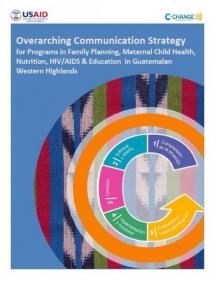Overarching Communication Strategy for Programs in Family Planning, Maternal Child Health, Nutrition, HIV/AIDS & Education in Guatemalan Western Highlands
This strategy will ensure that SBCC interventions (i.e. peer education/outreach, supportive communication materials, advocacy, social media etc.) are targeted and tailored to address barriers to social and behavior change, using a an approach that combines interventions appropriate to audience life-stages.
The key elements of the strategy include:
- Integrating components of the 5 health/education interventions will help ensure consistency of information delivery; create efficiencies and economies of scale; avoid confusion associated with inconsistent and contradictory messages; limit duplication of effort and materials; and make it easier for clients, consumers, and families to act.
- Integrating health content around specific life-stages provides a common anchor or positioning – “The Healthy Family/Community” – while ensuring specific/critical health messages are not lost.
- Integrating interventions across sectors (public, NGO, and private) to build on the comparative advantages of multiple partners, each playing to their unique strengths based on their roles and relationships with the various life-stages.
- Integrating communication tools and approaches will lead to stronger and more strategic links across communication channels including mass media, local media, commercial marketing, community/groups interactions, interpersonal communication, and health and education counseling.
Source: FHI360
Date of Publication: March 25, 2019
SIMILIAR RESOURCES
Tools
Examples
- Adolescents Living with HIV (ALHIV) Toolkit
- Positive Connections: Leading Information and Support Groups for Adolescents Living with HIV
- Consolidated Guideline on Sexual and Reproductive Health and Rights of Women Living with HIV
- Optimizing Entry Into and Retention in HIV Care and ART Adherence for PLWHA
- Engaging Men in HIV and AIDS at the Service Delivery Level
- Toolkit for Transition of Care and Other Services for Adolescents Living with HIV
- The Behavior Change Framework
- Accelerator Behaviors
- Infant and Young Child Feeding Recommendations When COVID-19 is Suspected or Confirmed
- HIV and Sexual and Reproductive Health Programming: Innovative Approaches to Integrated Service Delivery

